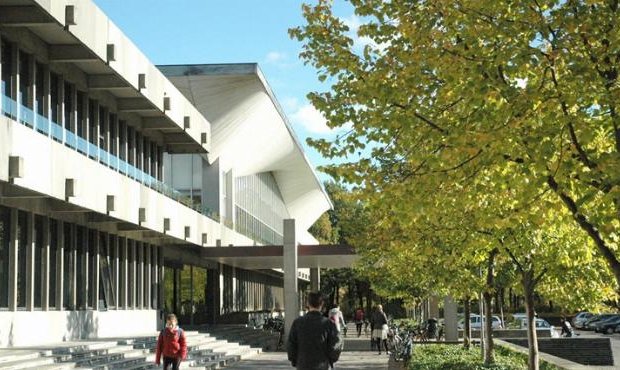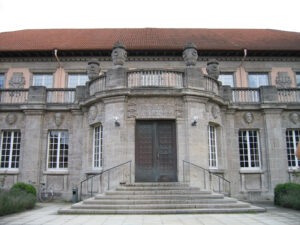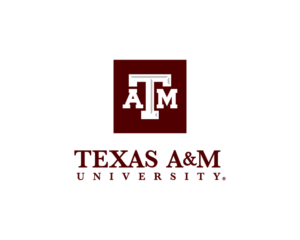
The laser chip company Octlight is one of 850 companies that have been created based on DTU projects over the past ten years. In the same period, the University has built up an extensive ecosystem for entrepreneurship.
It took eight years for Octlight to develop the laser chip. It’s similar to the chip used for facial recognition in mobile phones. The components are so small that they’re invisible to the naked eye, but integrated into the right electronic circuits, a laser diode can take retina measurements and diagnoses of visual function and eye diseases to a whole new level.
“From the very beginning, I wanted to move fast, but in deep tech it often takes up to 10 years to develop technology. Other entrepreneurs from DTU can get started faster, for example if they have a measurement setup that can be presented as a product to customers. Developing technology can be a long and gruelling process, but it can also help people all over the world, which is a huge motivating factor,” says Octlight’s founder and CEO Thor Ansbæk.
The design of the laser chip, in which the laser is integrated into a VCSEL laser chip (Vertical-Cavity Surface-Emitting Laser), was originally developed and patented as part of a research collaboration between the two DTU researchers Peter E. Andersen, who conducts research into biomedical optics, and Kresten Yvind, CTO at Octlight and Professor of laser development at DTU. Both researchers have studied the development of lasers for eye diagnostics and semiconductor technology for several years.
Octlight has entered into a licencing agreement with DTU, which means they have the rights to use the patent and to produce microchips in DTU’s cleanroom, Nanolab, in exchange for DTU receiving a share of the revenue in the form of royalties. The company’s first finished units are being tested at MedTech companies that develop products for ophthalmologists, who make up the primary market for the product. The next task will be marketing to customers in the area of glass quality control and laser processing.
Entrepreneurial dream
Even before his studies at DTU, Thor Ansbæk wanted to develop technology that could be used for something concrete.
“I was very attracted to DTU’s slogan ‘making it matter’—designing something that can make a difference in the world. And when I first started specializing in making microsystems on chips in DTU’s cleanroom, I was keen to start a high-tech company,” says Thor Ansbæk.
He applied to DTU in 2003 and completed a programme in semiconductor technology at DTU Electro and DTU Nanolab, where he designed microsystems. In the cleanroom, he met Professor Kresten Yvind from DTU, who suggested that he do a PhD on a laser light source that could be used for eye diagnostics.
Thor Ansbæk’s plan was to develop laser technology during his PhD studies. In the same period, he took various startup courses, and in 2006 he participated in one of the first Danish entrepreneur boot camps at Aalborg University. His team won first prize, which was a trip to Silicon Valley in the US.
“During my PhD, I already had a business plan and started working on the project with one of my fellow students. We made good progress, and when I finished my PhD we had the first prototype, which meant we could submit a patent application,” Thor Ansbæk remembers.
Proof of concept funding
Having the prototype as proof of concept enabled the duo to apply to DTU for funding to further develop the technology as early as 2012. Subsequently, Thor started his first job as a development engineer at NKT Flexibles. After six months, he received a phone call from the then innovation manager at DTU Photonics, Jes Broeng, who told him the funding application had been approved. After that, things moved quickly.
Thor received a grant of DKK 750,000 for further development of the project, salary, materials, and necessary travel to seek out the professional environments where the technology was relevant. He attended international conferences such as Photonics West and OCT for Non-Destructive Testing to find interested customers and companies to collaborate with.
“From working on a nerdy laser technology project, I had to go out and meet people and talk about why it was such a great idea. And it went really well. I was introduced to a colleague who’d done a PhD in deep tech 15 years earlier, and he ended up becoming a consultant for Octlight. Another contact with a company led to us to set up some feasibility tests, which made it possible to investigate a specific application of the technology,” says Thor Ansbæk.
Advisory board
At DTU, Thor Ansbæk benefited from the first initiatives to support innovation. Former innovation manager at DTU Photonics, Jes Broeng, set up an advisory board for the project, which provided input and feedback on how the project could move forward.
“We’re super lucky to have been based at DTU. It’s opened a lot of doors for us. We’ve had access to labs, collaboration with students, and advice from the innovation manager Jes Broeng, who himself has experience with a startup. And then we hit the wave with DTU’s first innovation initiative Createk, which was the forerunner of the current DTU Skylab,” says Thor Ansbæk.
Researchers at work in DTU’s clean room.
They were given an office at DTU, as well as access to the cleanroom, where electronics students who were doing a course project helped develop some of the electronics that make up the product today. It wasn’t until 2014 that Thor Ansbæk, Brian Øland, and Kresten Yvind founded the company Octlight in connection with the Danish Tech Challenge. However, it was only when the company entered into a financing agreement with Syddansk Innovation in 2015 that it was able to move into an office in the DTU Science Park and start developing and producing the first units.
Proximity to DTU is key
Thor Ansbæk stresses that it’s crucial for Octlight to be able to stay at DTU. The company’s raison d’être is that it can produce the VCSEL chip, and this is only possible because it has access to the cleanroom and the know-how available at DTU. The DTU Nanolab is unique in Europe in that it’s an ISO9001-certified cleanroom with activities ranging from research to small-scale production, and it’s provided the setting for several DTU startups.
“Producing our laser chip involves 160 steps. They all have to be done correctly in order for us to have a product in the end. Making it all work is a huge task. It involves everything from putting the materials in an acid bath to putting it in a machine that puts some polymer on it, to another machine where you put some metals on it. These steps are done one after the other, and one of them involves using a machine that can make a nano-sized patterning of the surface,” explains Thor Ansbæk.
The production process requires an effort from the entire Octlights team, and they needed to have a finished chip to be able to reach customers and show that it’s an interesting technology. This exercise has been successful, and Octlight’s laser chip is currently undergoing testing by companies in Europe, China, and the US that produce OCT equipment for scanning the retina and optic nerve.
The next step in the company’s development will be to attract sufficient funding to scale up production and be able to deliver laser chips in large quantities, says Thor.
“A customer will buy between 100-1,000 units for their product a year. And right now, we have one employee who’s making these semiconductor chips. And it’s a heroic effort for one woman to be producing all these units singlehandedly. It needs to be scaled up. All the process steps have to be optimized and made ready for everything to run and produce the expected result every time,” says Thor Ansbæk.
Octlight expects to stay at DTU Science Park as long as the company develops and produces its product. The proximity to DTU ensures that the company has a short distance to crucial infrastructure, partners at the University, and talented new researchers.



